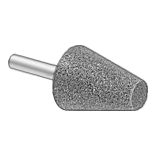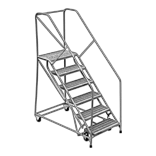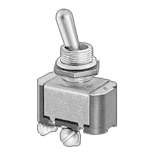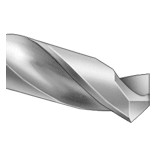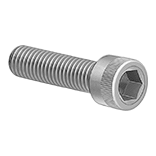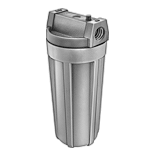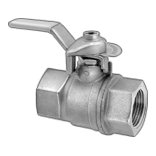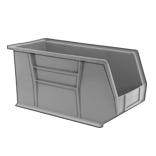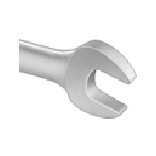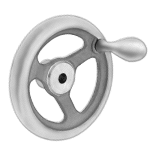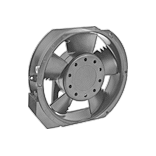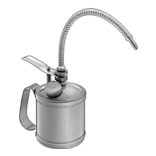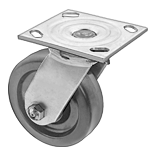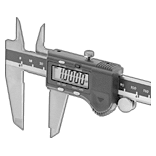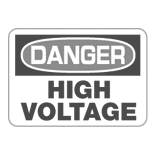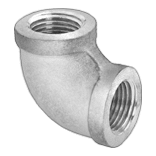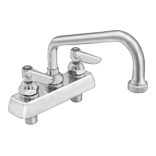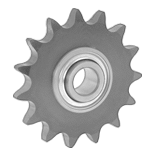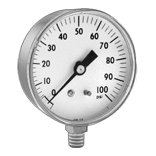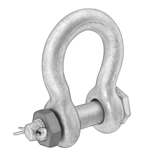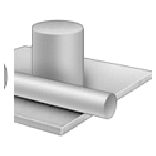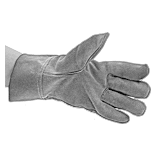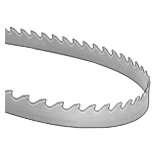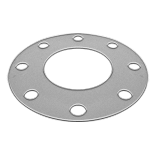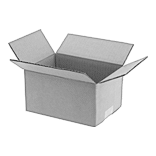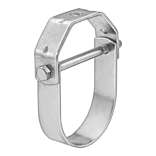Mitutoyo Dial Bore Gauge Sets

Detect variations in a range of hole diameters and depths. These sets include one dial head that fits onto three gauge bodies and 26 anvils to switch out for different holes. Use them to test engine cylinders, machine components, and other parts for issues with roundness and taper. They have a two-point contact system, which is the most common design for bore gauges. An internal pendulum balances the contact points at the true center of a hole, even if the gauge is tilted. To prevent heat from your hands skewing accuracy, all the gauges have hollow grips, which also make them easy to hold. The dial head’s highly sensitive, wear-resistant jeweled bearings contribute to a long service life, and its cover protects against scratches and drops.
Check size deviations by first setting the desired measurement with a ring gauge, bore gauge calibrator, micrometer, or caliper. The dial will display the magnitude of variation from the set measurement.
Dial | ||||||||||||||
|---|---|---|---|---|---|---|---|---|---|---|---|---|---|---|
| Measuring Range | Accuracy | Measuring Increments | Max. Dp. Measured | Probe Type | Measurement per Dial Revolution | Material | Industry Designation | Dia. | Face Color | No. of Anvils | Features | Manufacturer Model No. | Each | |
| 0.7"-6" | ±0.00008" | 0.0001" | 4", 6" | Interchangeable Anvil | 0.01" | Steel | AGD Group 2 | 2 1/4" | White | 26 | Dial Cover, Hollow Grips, Internal Pendulum Mechanism | 511-932 | 00000000 | 000000000 |
| 18mm-150mm | ±0.002 mm | 0.001mm | 100mm, 150mm | Interchangeable Anvil | 0.2mm | Steel | AGD Group 2 | 2 1/4" | White | 26 | Dial Cover, Hollow Grips, Internal Pendulum Mechanism | 511-922 | 000000000 | 00000000 |
Mitutoyo Dial Bore Gauges

Measure the inside diameter of holes and cylindrical bores, as well as identify out-of-roundness problems. These gauges are often used to test engine cylinders, machine components, and other parts for issues with roundness and taper. They have the most common design for bore gauges—a two-point contact system. Even if the gauge is tilted, an internal pendulum balances the contact points at the true center of a hole. Hollow grips make these gauges easy to hold and prevent heat from your hands from skewing accuracy. For a long service life, the dial head has highly sensitive jeweled bearings that resist wear. Its plastic cover protects against scratches and drops.
To use these bore gauges, set a baseline measurement with a ring gauge, calibrator, micrometer, or caliper. The variation from the set measurement displays on the dial right away, so there’s no need for conversions. Swap out the anvil to measure bores of different diameters.
Dial | ||||||||||||||
|---|---|---|---|---|---|---|---|---|---|---|---|---|---|---|
| Measuring Range | Accuracy | Measuring Increments | Max. Dp. Measured | Probe Type | Measurement per Dial Revolution | Material | Industry Designation | Dia. | Face Color | Number of Anvils | Manufacturer Model Number | Features | Each | |
| 0.7"-1.4" | ±0.00008" | 0.0001" | 4" | Interchangeable Anvil | 0.01" | Steel | AGD Group 2 | 2 1/4" | White | 9 | 511-751 | Internal Pendulum Mechanism, Dial Cover, Hollow Grips | 000000000 | 0000000 |
| 1.4"-2.5" | ±0.00008" | 0.0001" | 6" | Interchangeable Anvil | 0.01" | Steel | AGD Group 2 | 2 1/4" | White | 6 | 511-752 | Internal Pendulum Mechanism, Dial Cover, Hollow Grips | 000000000 | 000000 |
| 2"-6" | ±0.00008" | 0.0001" | 6" | Interchangeable Anvil | 0.01" | Steel | AGD Group 2 | 2 1/4" | White | 11 | 511-753 | Internal Pendulum Mechanism, Dial Cover, Hollow Grips | 000000000 | 000000 |
| 4"-6.5" | ±0.00008" | 0.0001" | 6" | Interchangeable Anvil | 0.01" | Steel | AGD Group 2 | 2 1/4" | White | 13 | 511-754 | Internal Pendulum Mechanism, Dial Cover, Hollow Grips | 000000000 | 000000 |
| 6.5"-10" | ±0.00008" | 0.0001" | 10" | Interchangeable Anvil | 0.01" | Steel | AGD Group 2 | 2 1/4" | White | 6 | 511-755 | Internal Pendulum Mechanism, Dial Cover, Hollow Grips | 00000000 | 000000 |
| 10"-16" | ±0.00008" | 0.0001" | 10" | Interchangeable Anvil | 0.01" | Steel | AGD Group 2 | 2 1/4" | White | 5 | 511-756 | Internal Pendulum Mechanism, Dial Cover, Hollow Grips | 00000000 | 000000 |
Dial | ||||||||||||||
|---|---|---|---|---|---|---|---|---|---|---|---|---|---|---|
| Measuring Range | Accuracy | Measuring Increments | Max. Dp. Measured | Probe Type | Measurement per Dial Revolution | Material | Industry Designation | Dia. | Face Color | Number of Anvils | Manufacturer Model Number | Features | Each | |
| 18 mm-35 mm | ±0.002 mm | 0.001 mm | 100 mm | Interchangeable Anvil | 0.2 mm | Steel | AGD Group 2 | 2 1/4" | White | 9 | 511-721 | Internal Pendulum Mechanism, Dial Cover, Hollow Grips | 00000000 | 0000000 |
| 35 mm-60 mm | ±0.002 mm | 0.001 mm | 150 mm | Interchangeable Anvil | 0.2 mm | Steel | AGD Group 2 | 2 1/4" | White | 6 | 511-722 | Internal Pendulum Mechanism, Dial Cover, Hollow Grips | 00000000 | 000000 |
| 50 mm-150 mm | ±0.002 mm | 0.001 mm | 150 mm | Interchangeable Anvil | 0.2 mm | Steel | AGD Group 2 | 2 1/4" | White | 11 | 511-723 | Internal Pendulum Mechanism, Dial Cover, Hollow Grips | 00000000 | 000000 |
Economy Dial Bore Gauges

Use these bore gauges to measure the inside diameter of holes and cylindrical bores, as well as identify out-of-roundness problems. Since they measure in increments of 0.0005", they’re useful for general checks. They’re often used to test parts where deviations in roundness or size can lead to wear or inefficiency, such as in engine cylinders, machine components, and turbines. Unlike calipers and inside micrometers, these bore gauges have a long shaft to reach into deep cylinders. They have a two-point contact system, which is the most common design for bore gauges.
To use these bore gauges, set a baseline measurement with a ring gauge, calibrator, micrometer, or caliper. The variation from the set measurement displays on the dial right away, so there’s no need for conversions. Swap out the anvil to measure bores of different diameters. All these gauges have jeweled bearings that resist wear for a long service life.
For technical drawings and 3-D models, click on a part number.
Dial | |||||||||||||
|---|---|---|---|---|---|---|---|---|---|---|---|---|---|
| Measuring Range | Accuracy | Measuring Increments | Max. Dp. Measured | Probe Type | Measurement per Dial Revolution | Material | Industry Designation | Dia. | Face Color | Number of Anvils | Contact Point Material | Each | |
| 0.7"-1.5" | ±0.0009" | 0.0005" | 8" | Interchangeable Anvil | 0.05" | Steel | AGD Group 2 | 2 1/4" | White | 8 | Carbide | 0000000 | 0000000 |
| 1.4"-6" | ±0.0009" | 0.0005" | 9" | Interchangeable Anvil | 0.05" | Steel | AGD Group 2 | 2 1/4" | White | 15 | Carbide | 0000000 | 000000 |
| 2"-6" | ±0.0009" | 0.0005" | 9" | Interchangeable Anvil | 0.05" | Steel | AGD Group 2 | 2 1/4" | White | 11 | Carbide | 0000000 | 000000 |
Starrett Dial Bore Gauges

Check a hole’s diameter and detect out-of-roundness problems. Often used to test engine cylinders and machine components, these gauges catch issues with roundness and taper. They have the most common design for bore gauges, which is a two-point contact system. The dial head’s highly sensitive jeweled bearings resist wear for a long service life.
To use these bore gauges, set a baseline measurement with a ring gauge, calibrator, micrometer, or caliper. The variation from the set measurement displays on the dial right away, so there’s no need for conversions. Swap out the anvil to measure bores of different diameters. Marked by size, the anvils are quick to spot and select.
Dial | ||||||||||||||
|---|---|---|---|---|---|---|---|---|---|---|---|---|---|---|
| Measuring Range | Accuracy | Measuring Increments | Max. Dp. Measured | Probe Type | Measurement per Dial Revolution | Material | Industry Designation | Dia. | Face Color | Number of Anvils | Manufacturer Model Number | Includes | Each | |
| 0.7"-1.5" | ±0.0005" | 0.0005" | 6" | Interchangeable Anvil | 0.05" | Steel | AGD Group 2 | 2 1/4" | White | 10 | 3089Z-131-715J | __ | 00000000 | 0000000 |
| 1.4"-2.4" | ±0.0005" | 0.0005" | 6" | Interchangeable Anvil | 0.05" | Steel | AGD Group 2 | 2 1/4" | White | 6 | 3089Z-131-1424J | __ | 00000000 | 000000 |
| 2"-6" | ±0.0005" | 0.0005" | 6" | Interchangeable Anvil | 0.05" | Steel | AGD Group 2 | 2 1/4" | White | 11 | 3089Z-131-26J | 2" Lg. Extension | 00000000 | 000000 |
Mitutoyo Dial Bore Gauges with Micrometer Head

No need for other tools to set a baseline diameter—these bore gauges have a built-in micrometer head. Use them to check diameters and test for issues with roundness in engine cylinders and other parts. They have a two-point contact system, which is the most common design for bore gauges. For a long service life, the jeweled bearings in the dial head resist wear, and a plastic cover protects the head from scratches and drops. With hollow grips, these bore gauges are easy to hold and prevent heat from your hands from skewing accuracy.
To use them, set a baseline measurement with the micrometer head. As you move the gauge in the hole, the variation from the set measurement displays on the dial right away. Switch out the anvil to measure bores of different diameters.
Dial | ||||||||||||||
|---|---|---|---|---|---|---|---|---|---|---|---|---|---|---|
| Measuring Range | Accuracy | Measuring Increments | Max. Dp. Measured | Probe Type | Measurement per Dial Revolution | Material | Industry Designation | Dia. | Face Color | Number of Anvils | Features | Manufacturer Model Number | Each | |
| 2.4"-4" | ±0.00008" | 0.0001" | 6" | Interchangeable Anvil | 0.01" | Steel | AGD Group 2 | 2 1/4" | White | 2 | Dial Cover, Hollow Grips | 511-853 | 0000000 | 0000000 |
| 4"-6.4" | ±0.00008" | 0.0001" | 6" | Interchangeable Anvil | 0.01" | Steel | AGD Group 2 | 2 1/4" | White | 3 | Dial Cover, Hollow Grips | 511-854 | 0000000 | 000000 |
| 6"-10" | ±0.00008" | 0.0001" | 6" | Interchangeable Anvil | 0.01" | Steel | AGD Group 2 | 2 1/4" | White | 4 | Dial Cover, Hollow Grips | 511-855 | 0000000 | 000000 |
Starrett Dial Bore Gauge Sets

Test for size deviations across a range of hole diameters. These sets include 3 gauges and over 25 anvils marked by size for quick changes. Use them to test engine cylinders, machine components, and other parts for issues with roundness and taper. They have a two-point contact system, which is the most common design for bore gauges. For a long service life, the jeweled bearings in each dial head resist wear, and a plastic cover protects the head from scratches and drops.
Check size deviations by first setting the desired measurement with a ring gauge, bore gauge calibrator, micrometer, or caliper. The dial will display the magnitude of variation from the set measurement.
Dial | ||||||||||||||
|---|---|---|---|---|---|---|---|---|---|---|---|---|---|---|
| Measuring Range | Accuracy | Measuring Increments | Max. Dp. Measured | Probe Type | Measurement per Dial Revolution | Material | Industry Designation | Dia. | Face Color | Number of Anvils | Features | Manufacturer Model Number | Each | |
| 0.7"-6" | ±0.0005" | 0.0005" | 6" | Interchangeable Anvil | 0.05" | Steel | AGD Group 2 | 2 1/4" | White | 27 | Laser-Marked Anvils | S3089Z-131-6J | 0000000 | 0000000 |
| 50mm-160mm | ±0.01 mm | 0.01mm | 150mm | Interchangeable Anvil | 0.1mm | Steel | AGD Group 2 | 2 1/4" | Yellow | 26 | Laser-Marked Anvils | S3089MZ-181-160J | 0000000 | 000000 |
Mitutoyo Flat-Bottom Dial Bore Gauges
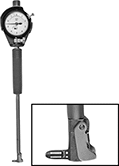
Check roundness, taper, and diameter near the bottom of bores—the flat bottom on these gauges positions the anvil against the base of the hole. Because they reach down into bores, they are a better choice for measuring deep holes than calipers or inside hole micrometers. They are comparison gauges—the dial will display the magnitude of variation from the set measurement. Set your desired measurement with a ring gauge, bore gauge calibrator, micrometer, or caliper.
The anvil on the gauges extends out and contacts two points to take measurements. Swap the included anvils to measure bores with different diameters. An internal pendulum keeps these gauges centered as they slide into a bore and positions the anvils perpendicular to the bore surface. This results in more contact with the bore for consistent and accurate measurements. These gauges have hollow grips for easy handling. They also prevent body heat from causing the material of the gauge to expand and impact accuracy. A plastic cover on the dial protects it from drops and scratches.
Dial | ||||||||||||||
|---|---|---|---|---|---|---|---|---|---|---|---|---|---|---|
| Measuring Range | Accuracy | Measuring Increments | Max. Dp. Measured | Probe Type | Measurement per Dial Revolution | Material | Industry Designation | Dia. | Face Color | Number of Anvils | Features | Manufacturer Model Number | Each | |
| 0.6"-1.4" | ±0.0002" | 0.0001" | 6" | Flat-Bottom Interchangeable Anvil | 0.01" | Steel | AGD Group 2 | 2 1/4" | White | 11 | Dial Cover, Hollow Grips, Internal Pendulum Mechanism | 511-438 | 0000000 | 0000000 |
| 1.4"-2.4" | ±0.0002" | 0.0001" | 6" | Flat-Bottom Interchangeable Anvil | 0.01" | Steel | AGD Group 2 | 2 1/4" | White | 6 | Dial Cover, Hollow Grips, Internal Pendulum Mechanism | 511-439 | 0000000 | 000000 |
| 2"-6" | ±0.0002" | 0.0001" | 6" | Flat-Bottom Interchangeable Anvil | 0.01" | Steel | AGD Group 2 | 2 1/4" | White | 11 | Dial Cover, Hollow Grips, Internal Pendulum Mechanism | 511-440 | 0000000 | 000000 |
Mitutoyo Pocket Dial Bore Gauges

With a short stem, these gauges easily maneuver in shallow holes and are compact enough to slip into your pocket. Use them to check the diameter and roundness of a hole. They are comparison gauges—the dial will display the magnitude of variation from the set measurement. Set your desired measurement with a ring gauge, bore gauge calibrator, micrometer, or caliper.
The anvil on the gauges extends out and contacts two points to take measurements. Swap the included anvils to measure bores with different diameters. These gauges have hollow grips for easy handling. They also prevent body heat from causing the material of the gauge to expand and impact accuracy. A plastic cover on the dial protects it from drops and scratches.
Dial | ||||||||||||||
|---|---|---|---|---|---|---|---|---|---|---|---|---|---|---|
| Measuring Range | Accuracy | Measuring Increments | Max. Dp. Measured | Probe Type | Measurement per Dial Revolution | Material | Industry Designation | Dia. | Face Color | Number of Anvils | Manufacturer Model Number | Features | Each | |
| 0.7"-1.4" | ±0.00008" | 0.0001" | 2" | Interchangeable Anvil | 0.01" | Steel | AGD Group 2 | 2 1/4" | White | 9 | 511-791 | Hollow Grips | 0000000 | 0000000 |
| 1.4"-2.5" | ±0.00008" | 0.0001" | 2" | Interchangeable Anvil | 0.01" | Steel | AGD Group 2 | 2 1/4" | White | 6 | 511-792 | Hollow Grips | 0000000 | 000000 |
| 2"-6" | ±0.00008" | 0.0001" | 2" | Interchangeable Anvil | 0.01" | Steel | AGD Group 2 | 2 1/4" | White | 11 | 511-793 | Hollow Grips | 0000000 | 000000 |
Electronic Bore Gauges
Find a hole’s ID without having to compare it against a set measurement like you do with dial bore gauges. These gauges have an LCD display, making it easy to read the diameter. To measure holes with different diameters, swap out the anvil. Each anvil has two contact points to detect out-of-roundness. Use them to find issues with size that can cause precision parts, such as engine or valve cylinders, to wear quickly or run poorly. All have zero-position memory, also known as absolute (ABS) positioning, which retains the gauge’s measuring position when turned off. A zero-set button allows you to start measuring at any point.
Extensions (sold separately) lengthen the stem of your gauge to reach farther into deep bores.

Gauges | 20" Lg. Extensions | 40" Lg. Extensions | |||||||||||
|---|---|---|---|---|---|---|---|---|---|---|---|---|---|
| Measuring Range | Accuracy | Measuring Increments | Max. Dp. Measured | Probe Type | Material | Batteries Included | Number of Anvils | Each | Each | Each | |||
| 1.4"-6" | ±0.0006" | 0.00005" | 9" | Interchangeable Anvil | Steel | Yes | 15 | 0000000 | 0000000 | 00000000 | 0000000 | 00000000 | 0000000 |
| Replacement Battery (1/Pkg.) | 0000000 | Pkg. | 00000 |
Mitutoyo Electronic Bore Gauges
Measure bore diameter directly. These gauges give you the actual diameter, unlike a dial bore gauge, which only shows the variation from a set measurement. An LCD display makes the diameter easy to read. They measure deeper into smaller holes than inside hole micrometers. To test holes of different sizes, swap among the included anvils. Each anvil has two contact points that detect issues with roundness and taper and a flat bottom for stability in blind holes. For repeatable go and no-go tests, set upper and lower tolerances. A bar indicator on the display shows whether your measurement is within bounds, making test results quick to check.
An SPC data output allows you to connect these gauges to a computer or data processor to analyze data and monitor measurements in real time. A zero-set button lets you start measuring at any point. All have zero-position memory, also known as absolute (ABS) positioning, which retains the measuring position when the gauge is turned off. These gauges have alarms to warn you about various issues, including a low battery and setting errors.
Extension rods (sold separately) lengthen the stem of your gauge to reach farther into deep bores.
Gauge blocks (sold separately) come in eight different metric sizes for calibrating your bore gauge.
Data cables (sold separately) connect your gauge to your PC to send data.

Interchangeable
Anvil Probe
Gauges | Replacement Batteries | |||||||||||
|---|---|---|---|---|---|---|---|---|---|---|---|---|
| Measuring Range | Accuracy | Measuring Increments | Max. Dp. Measured | Probe Type | Material | Batteries Included | Number of Anvils | Manufacturer Model Number | Each | Each | ||
| 1.8"-4" 45 mm-100 mm | ±0.0001" ±0.003 mm | 0.00005" 0.001 mm | 6" | Flat-Bottom Interchangeable Anvil | Steel | Yes | 12 | 511-521 | 0000000 | 000000000 | 00000000 | 00000 |
| 4"-6.5" 100 mm-160 mm | ±0.0001" ±0.003 mm | 0.00005" 0.001 mm | 6" | Flat-Bottom Interchangeable Anvil | Steel | Yes | 13 | 511-522 | 0000000 | 00000000 | 00000000 | 0000 |
